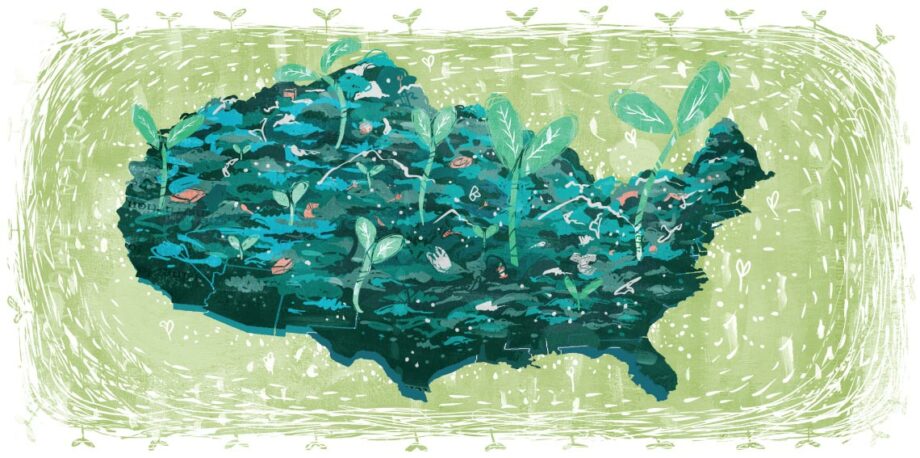February 19, 2013 — The idea struck me during a meeting. While thoughts of waste don’t routinely course through my brain, trash was the subject matter at a meeting of Duke’s Campus Sustainability Committee whose broad focus is to maximize the sustainability of all Duke’s operations. The discussion in this particular meeting centered on how to reduce and eventually eradicate our waste stream.
The thing that really caught my attention was a report on the results of a series of student dumpster dives around campus. After collecting and sorting all the garbage, they found that about three-quarters of Duke’s so-called non-recyclable trash destined for area landfills was compostable — things like food scraps, napkins, paper towels, etc. Based on calculations from government data [pdf], the national average is closer to 50 percent, but that’s still a lot of compost mostly headed for a landfill.
Trash Talking
You may call it trash or garbage, but the Environmental Protection Agency’s technical term for the stuff we toss into garbage cans and dumpsters is municipal solid waste: “everyday items we use and then throw away, such as product packaging, grass clippings, furniture, clothing, bottles, food scraps, newspapers, appliances, paint and batteries.”
The United States throws away some 250 million tons worth of this stuff a year — a hefty MSW number that places us solidly in the No. 1 spot for trash production.
The real challenge in making a compost economy is moving our compostable trash toward 100 percent. Let’s replace recyclable, petroleum-based plastics with non-toxic, cellulosic, compostable plastics.
On the bright side, not all the trash we Americans produce [pdf] ends up in landfills. Individually we recycle or compost about 1.5 pounds of the 4.5 pounds each American produces every day. Nationally, approximately 26 percent of our waste stream is recycled, 12 percent is burned to produce energy and 8 percent is composted. Still, that leaves about 136 million tons piling up in landfills every year.
What to do?
One shining example of waste trimming is San Francisco, which reportedly “diverts 77% of its waste from landfills” and has its sights set on “zero waste” by 2020. Seattle and Los Angeles have also made great strides in shrinking their garbage footprint. Such initiatives (see also here and here) are certainly a move in the right direction.
But what about an approach that goes even further? One that does away with having to sort trash into the recycling box, the compost heap and the trash bin? One that doubles down on composting by moving up the value chain to create a “composting consumer economy.”
Moving Past Post-Consumer Recyclables to Post-Consumer Compost
Right now we send a lot of compostable materials to landfills. If you’ll pardon the pun, that’s a waste. Instead of being treated like trash, compostable items can be converted into organic-rich soil for growing crops. And that could even help slow climate change. The anaerobic decay that occurs in landfills produces methane, a greenhouse gas that can escape into the atmosphere if a gas-capturing system is not installed. Composting, which is primarily an aerobic process, generates very little methane.
But the real challenge in making a compost economy is moving our compostable trash toward 100 percent. Let’s replace recyclable, petroleum-based plastics with nontoxic, cellulosic, compostable plastics. In addition to making compostable products, let’s make the packaging compostable too. And I am talking truly compostable [pdf]—not just biodegradable and not compostable with caveats (e.g., compost that requires high temperatures to break down) and certainly not toxic.
All compostable products needn’t even be intended for the garbage can. For disposable items that are manufactured by the billions but whose useful “lifespans” are minutes—for instance the plasticware that dominates cafeterias, fast-food chains and take-out—how about making them edible? (See here and here.) It’s a “technology” I remember as a kid on the Rockaway Beach boardwalk in the ’50s. Other baby-boomer New Yorkers recall Lee’s Tuckee Cup, too — a real happy meal, good to the last, er, cup.
The bottom line is recycling is good, but it’s not going to get us even close to the goal of zero landfill waste. A consumer economy centered around compostable products is a lot sounder and could even be tasty.
Editor’s note: The views expressed here are those of the author and not necessarily of Ensia. We present them to further discussion around important topics. We encourage you to respond with a comment below, following our commenting guidelines, which can be found here. In addition, you might consider submitting a Voices piece of your own. See Ensia’s “Contact” page for submission guidelines.
Ensia shares solutions-focused stories free of charge through our online magazine and partner media. That means audiences around the world have ready access to stories that can — and do — help them shape a better future. If you value our work, please show your support today.
Yes, I'll support Ensia!

In addition to the San Francisco and the urban examples, there is considerable zero waste energy in rural areas as well. Check out the award winning Appalachian Zero Waste Initiative here in southeastern Ohio, a partnership of NGOs like Rural Action, universities like Ohio University's Voinovich School of Leadership and Public Affairs, foundations like Sugarbush, and local and state government. http://ruralaction.org/programs/zerowaste/
Work out of the State of Oregon shows that even with relatively high rates of separation of compostable products from the waste stream, landfill emissions are higher than using equivalent oil-based products and recycling. Many businesses like to use compostable products to show their green cred with knowing (or caring) that having these products thrown in the trash is probably worse from a climate perspective.
We should emphasis collection programs and education first, to get at the 50% of the stream that is already compostable.
More here: http://netdensity.net/2013/02/20/2997
1. If almost all of the waste stream is compostable without recyclables, the problem of separation is moot;
2. Don’t send compostables to a landfill, send them to compost.